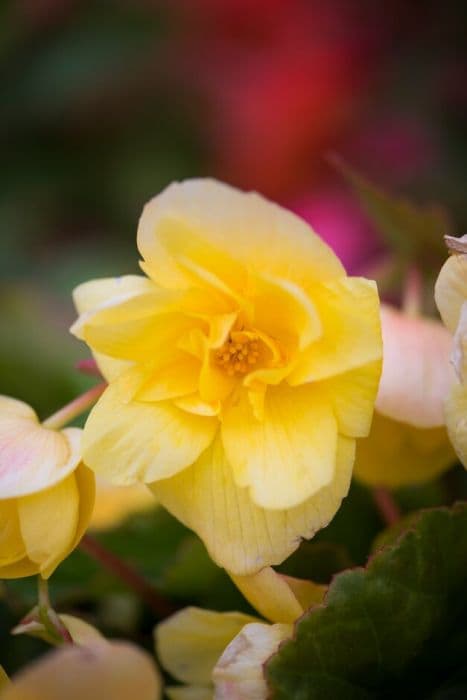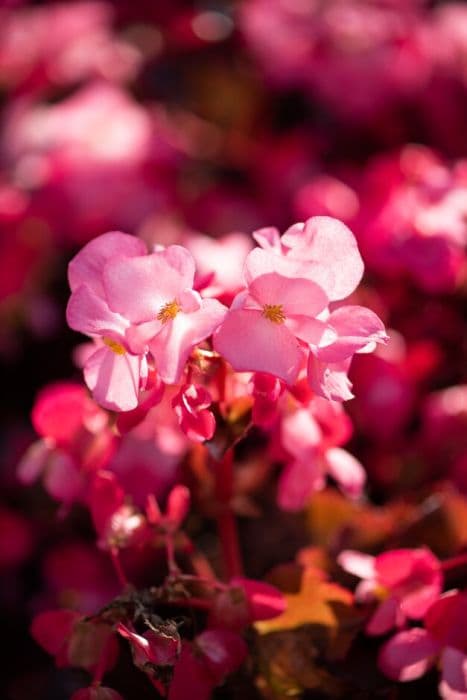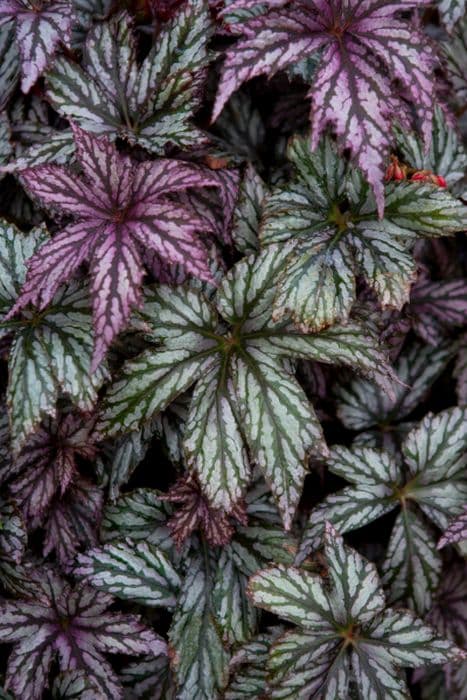Illumination Salmon Pink Begonia Begonia 'Illumination Salmon Pink' (Illumination Series) (T/d)

ABOUT
The Begonia 'Illumination Salmon Pink' from the Illumination Series is a delight to the senses with its cascading display of blooms and lush foliage. This variety, known for its vibrant flower color, bears a profusion of soft salmon pink blooms. The flowers of this begonia are characteristically double and pendulous, resembling delicate ruffled petals that cascade elegantly, making it an exceptional choice for hanging baskets or containers where the beauty of its trailing habit can be fully appreciated. The leaves of this begonia are equally striking, often a shimmering green that can sometimes appear to have a bronze hue, which serves as a beautiful backdrop for the pink blossoms. The foliage presents a mixture of shapes but typically holds to the common begonia leaf form—broad with a pointed tip and a slightly wavy or serrated edge, adding to the plant's overall lush appearance. Rich and abundant, the flowering display of the 'Illumination Salmon Pink' begonia is known to be long-lasting, ensuring that the plant remains a centerpiece of visual interest throughout the blooming season. Overall, the Begonia 'Illumination Salmon Pink' exudes a tropical charm, and despite the absence of size specifics, it's clear that the plant's trailing habit and profuse flowering make it a sizable addition to any garden or patio.
About this plant
 Names
NamesSynonyms
Illumination Salmon Pink Begonia, Dragon Wing Begonia, Angel Wing Begonia.
Common names
Begonia 'Illumination Salmon Pink' (Illumination Series) (T/d).
 Toxicity
ToxicityTo humans
Begonias, including the Illumination Salmon Pink begonia, contain insoluble oxalates, which can be mildly toxic if ingested. If consumed, these compounds can cause irritation in the mouth, lips, throat, and tongue. There can also be nausea, vomiting, and difficulty swallowing. Generally, symptoms are mild and can be managed by rinsing the mouth and drinking water; however, significant ingestion may require medical attention.
To pets
The Illumination Salmon Pink begonia is considered toxic to pets, including cats and dogs, due to insoluble oxalate crystals. If a pet ingests this plant, symptoms may include mouth irritation, excessive drooling, vomiting, and difficulty swallowing. The severity of the symptoms can depend on the amount ingested. Pet owners should be cautious and seek veterinary care if their pet shows signs of poisoning after consuming any part of the plant.
 Characteristics
CharacteristicsLife cycle
Perennials
Foliage type
Evergreen
Color of leaves
Green
Flower color
Salmon Pink
Height
1-1.5 feet (30-45 cm)
Spread
1-2 feet (30-60 cm)
Plant type
Herb
Hardiness zones
10
Native area
Tropical South America
Benefits
 General Benefits
General Benefits- Easy to Care For: Begonia 'Illumination Salmon Pink' is relatively easy to maintain, requiring minimal pruning and care, making it suitable for gardeners of all skill levels.
- Vibrant Blooms: It produces stunning salmon-pink flowers that can enhance the visual appeal of any garden or indoor space.
- Long Flowering Period: This Begonia variety has a longer blooming season, offering beautiful displays from early summer to the first frost.
- Suitable for Shade: It is an excellent choice for shaded gardens where other flowering plants may struggle to thrive.
- Versatile Planting Options: It can be planted in hanging baskets, containers, or garden beds, providing flexibility in garden design and space utilization.
- Attracts Pollinators: The bright flowers attract bees, butterflies, and other pollinators, promoting biodiversity.
- Drought Tolerant: Once established, Begonia 'Illumination Salmon Pink' can tolerate periods of dryness, reducing the need for frequent watering.
 Medical Properties
Medical PropertiesThis plant is not used for medical purposes.
 Air-purifying Qualities
Air-purifying QualitiesThis plant is not specifically known for air purifying qualities.
 Other Uses
Other Uses- Photography Projects: The vibrant salmon pink flowers of the Begonia can add a stunning visual element in macro photography or as a colorful subject in botanical photography.
- Edible Garnishes: While not commonly known for their edibility, the petals of Begonia flowers can be used as ornamental, edible garnishes for salads and desserts, provided they haven't been treated with any chemicals.
- Holiday Decorations: The Begonia's eye-catching foliage and flowers can be incorporated into festive wreaths or table centerpieces for holidays and special occasions.
- Teaching Tool: Used in educational settings, the Begonia can serve as a hands-on teaching aid for lessons on plant biology, pollination, and horticulture.
- Wedding Bouquets: The Begonia can be included in wedding bouquets or floral arrangements, providing a splash of color and a unique floral choice.
- Color Dye: The flowers may be used in natural dyeing processes to give fabrics or papers a delicate pink hue.
- Crafts and DIY Projects: Pressed Begonia flowers can be used in crafting, for example in homemade greeting cards, bookmarks, or decoupage projects.
- Perfume Inspiration: While they may not be used directly in perfumery, the Begonia's appearance can inspire the creation of fresh and floral perfume scents.
- Social Events: Begonias can serve as living decor for various social events like tea parties or garden luncheons, enhancing the table settings with their charm.
- Aquarium Landscaping: While not aquatic plants, the Begonia can be used creatively around aquariums to create a lush terrestrial plant background when positioned outside the tank.
Interesting Facts
 Feng Shui
Feng ShuiThe Begonia is not used in Feng Shui practice.
 Zodiac Sign Compitability
Zodiac Sign CompitabilityThe Begonia is not used in astrology practice.
 Plant Symbolism
Plant Symbolism- Caution: Begonias are often seen as a symbol of caution or warning, which may come from the fact that some begonia species have toxic parts.
- Harmony: The balanced and symmetrical petals of the begonia can represent harmony and balance in life.
- Individuality: The unique salmon pink color of this begonia cultivar might symbolize individualism and the embracing of one’s uniqueness.
- Unconventional Beauty: With their non-traditional hues, Illumination Salmon Pink Begonias may represent a beauty that is unconventional and stands out from the norm.
 Water
WaterTuberous begonias like the Illumination Salmon Pink begonia should be watered thoroughly when the top inch of soil feels dry. Depending on the humidity and temperature, this might mean watering once every 5-7 days. It's best to water these plants in the early morning or late afternoon to reduce evaporation. When watering, apply water directly to the base of the plant, avoiding wetting the foliage, which can lead to fungal diseases. Aim to provide between 16 to 24 ounces of water per plant during each watering session, ensuring the water penetrates the soil deeply but does not leave the soil waterlogged.
 Light
LightIllumination Salmon Pink begonias prefer bright, indirect sunlight. They thrive best in locations where they can receive plenty of light without being exposed to the harsh midday sun. An ideal spot would be an east- or west-facing windowsill, or a spot that receives filtered light through a sheer curtain. Direct morning light can be beneficial, but protection from strong afternoon rays is crucial to avoid scorching the leaves.
 Temperature
TemperatureIllumination Salmon Pink begonias perform well in temperatures between 60°F and 75°F. They can survive minimum temperatures of approximately 50°F, but should not be subjected to temperatures below this as they are sensitive to cold. During the day, maintaining a consistent temperature around the mentioned range is ideal for their growth, and during the night, temperatures can drop to the lower end without harming the plants.
 Pruning
PruningPrune your Illumination Salmon Pink begonias to remove any dead or dying flowers and leaves, which will encourage new growth and more blooms. Pinching off the tips of the stems can also promote bushier growth. Pruning is best done after the main bloom period, typically in late summer or early fall. This helps to maintain a compact shape and prevent the plants from becoming leggy.
 Cleaning
CleaningAs needed
 Soil
SoilFor the Illumination Begonia, a rich, well-draining soil mix is ideal. A blend of peat, pine bark, and perlite in equal parts works well, providing adequate aeration and moisture retention. The preferred pH range for this plant is between 5.5 and 6.5.
 Repotting
RepottingIllumination Begonias should be repotted every 1-2 years or when they outgrow their current container. Spring is the best time to repot to minimize stress on the plant.
 Humidity & Misting
Humidity & MistingIllumination Begonias thrive in high humidity levels, ideally around 50-70%. Use a pebble tray or humidifier to maintain these conditions, especially if indoor air is dry.
 Suitable locations
Suitable locationsIndoor
Place in bright, indirect light; ensure high humidity.
Outdoor
Sheltered spot, moderate sun, protect from frost.
Hardiness zone
10-11 USDA
 Life cycle
Life cycleThe Begonia 'Illumination Salmon Pink', from the Illumination Series, begins its life as a seed or more commonly through propagation from cuttings. After sowing or rooting, it enters a vegetative stage, where it develops roots, shoots, and leaves, thriving in warm conditions with indirect light. The plant then matures and enters the flowering stage, in which it produces distinctive salmon-pink blooms, usually from early summer to fall, depending on the climate. After blooming, if pollinated, the Begonia may produce small winged fruits containing seeds, completing its reproductive cycle. In temperate climates, the plant may die back during the colder months but can resprout from tubers or overwintered cuttings in the following growing season. Throughout its life cycle, Begonia 'Illumination Salmon Pink' requires consistent moisture, well-draining soil, and regular feeding during the growing season to maintain its vigorous growth and prolific flowering.
 Propogation
PropogationPropogation time
Spring-Early Summer
The Begonia 'Illumination Salmon Pink' is often propagated by taking stem cuttings, which is the most popular method for this plant. To propagate, select a healthy stem with a few leaves and cut just below a node using a clean, sharp pair of scissors or a knife. The cutting should be about 3 to 4 inches (about 7.5 to 10 centimeters) long. Remove the lower leaves to expose a section of stem. Dip the cut end into rooting hormone powder to encourage root growth, although this is optional. Then, insert the cutting into a moist potting mix or directly into water. If using soil, cover with a plastic bag to maintain humidity and place in indirect sunlight. Roots should emerge in a few weeks, at which point the cutting can be transplanted into a pot.





![Begonia [Devotion]](/_next/image?url=https%3A%2F%2Fplants-admin.emdemapps.com%2Fimages%2Fplants%2F%2Fimages%2F604b58183573b.png&w=640&q=75)



